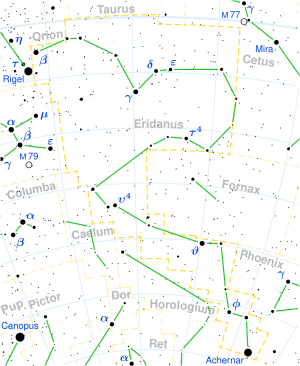2MASS J04151954−0935066
| Observation data Epoch J2000 Equinox J2000 | |
|---|---|
| Constellation | Eridanus |
| Right ascension | 04h 15m 19.54s |
| Declination | −09° 35′ 06.6″ |
| Characteristics | |
| Spectral type | T8V |
| Apparent magnitude (Y) | 16.438 ± 0.009[1] |
| Apparent magnitude (J) | 15.343 ± 0.004[1] |
| Apparent magnitude (H) | 15.666 ± 0.012[1] |
| Apparent magnitude (Ks) | 15.658 ± 0.023[1] |
| Details Gyr | |
2MASSW J0415195−093506 | |
| Database references | |
| SIMBAD | data |
Location of 2MASS 0415−0935 in the constellation Eridanus | |
2MASS J04151954−0935066 (also abbreviated to 2MASS 0415−0935) is a
Discovery
2MASS 0415−0935 was discovered in 2002 by Adam J. Burgasser et al. from
Distance
Currently the most precise distance estimate of 2MASS 0415−0935 is published in 2012 by Dupuy & Liu
Space motion
Position of 2MASS 0415−0935 shifts due to its
Properties
2MASS 0415-0935 belongs to the spectral class T8V; its surface temperature is about 750 kelvins. As with other brown dwarfs of spectral type T, its spectrum was thought to be dominated by methane, although by 2015 with the improved spectroscopic database many of the spectral lines were re-assigned to water.[5] The Research Consortium On Nearby Stars (RECONS) estimates the brown dwarf to be 0.03 solar masses.[8]
2MASS 0415-0935 was observed with NIRSpec on JWST. The observation constrained the abundances of water vapor (H2O), methane (CH4), carbon monoxide (CO), carbon dioxide (CO2) and ammonia (NH4). The abundance of hydrogen sulfide (H2S) was less well constrained and phosphine (PH3) was not detected, but an upper limit of its abundance was measured. The 12CO/13CO ratio is 97+9
−8, which is similar for 2MASS J03552337+1133437 and similar to the ratio in the sun. It was shown that the current models of vertical mixing that predict the abundances of different molecules are inconsistent with measured abundances of carbon dioxide. 2MASS 0415-0935 joins a number of T and Y-dwarfs with missing phosphine, such as WISE 0359−5401, requiring a major revision of phosphorus chemistry in brown dwarfs and possibly giant planets.[3]
See also
The other 10 brown dwarfs, presented in Burgasser et al. (2002):[6]
- 2MASS 0243−2453 (T6)
- 2MASS 0727+1710(T7)
- 2MASS 0755+2212 (T5)
- 2MASS 0937+2931(T6)
- 2MASS 1534−2952 (T5.5)
- 2MASS 1546−3325 (T5.5)
- 2MASS 1553+1532 (T7)
- 2MASS 2254+3123 (T5)
- 2MASS 2339+1352 (T5.5)
- 2MASS 2356−1553 (T6)
References
- ^ S2CID 119183225.
- ^ S2CID 119256363.
- ^ arXiv:2402.05345.
- ^ "2MASS J04151954-0935066 -- Brown Dwarf (M<0.08solMass)". SIMBAD. Centre de données astronomiques de Strasbourg. Retrieved 2012-11-24.
- ^
- ^ S2CID 9273465.
- S2CID 16344176.
- ^ "The 100 nearest star systems". Research Consortium On Nearby Stars. Georgia State University. January 1, 2012. Retrieved 2012-06-11.
Further reading
- Dupuy, Trent J.; Liu, Michael C. (2012). "The Hawaii Infrared Parallax Program. I. Ultracool Binaries and the L/T Transition". The Astrophysical Journal Supplement Series. 201 (2): 19. S2CID 119256363.
External links
- Entry at DwarfArchives.org Archived 2019-06-10 at the Wayback Machine


